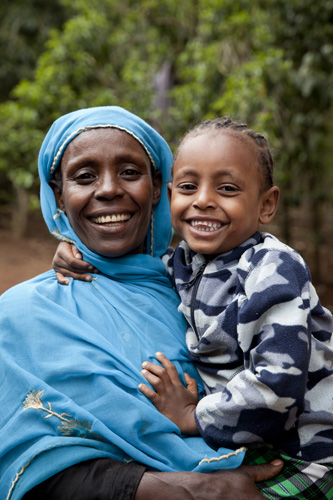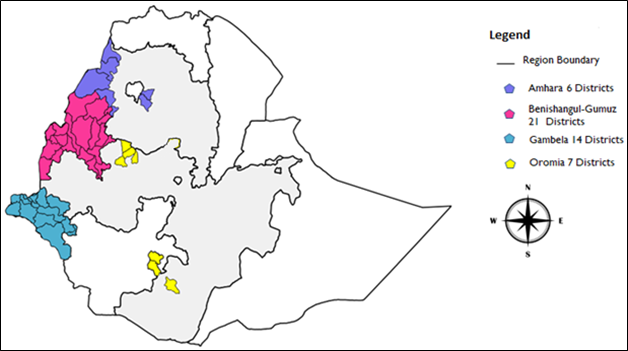 Though malaria prevalence in Ethiopia is relatively low compared to other African nations, nearly 70 percent of the population lives in areas at risk of malaria. Prompt access to quality malaria case management, including laboratory-based diagnosis in remote rural areas, has improved dramatically over the last decade as have surveillance systems that capture malaria cases and deaths.
Though malaria prevalence in Ethiopia is relatively low compared to other African nations, nearly 70 percent of the population lives in areas at risk of malaria. Prompt access to quality malaria case management, including laboratory-based diagnosis in remote rural areas, has improved dramatically over the last decade as have surveillance systems that capture malaria cases and deaths.
Since 2005, the Ethiopia Federal Ministry of Health (FMOH) IRS program, funded by the government and Global Fund, has protected between 9 and 17 million people annually from malaria. In 2018, the FMOH IRS program sprayed approximately 2.9 million structures across non-PMI target districts achieving 88% coverage of the target, and protecting more than 9.1 million people from malaria. The US Government has been supporting the FMOH to conduct IRS in Ethiopia since 2008. The 2018 and 2019 campaigns each targeted 44 districts, 20 in Benishangul-Gumuz, 14 in Gambela, and 10 in Oromia. In 2019, under the PMI VectorLink Ethiopia project, IRS was conducted in 44 districts, originally targeting 542,148 structures using Actellic 300CS from to May 20 to July 22, 2019. The target was reduced to 509,594 structures due to security issues that prohibited spray teams from reaching certain areas. A total of 487,746 structures were sprayed out of 510,449 structures found by spray operators in the targeted districts, accounting for a coverage rate of 95.5%.
Table 1 provides an overview of the number of sprayed structures and population protected from 2016 to 2019 including targets for 2020 by the PMI IRS program.
Table 1: Number Of Districts, Structures Sprayed, And Population Protected, 2016–2020
| Year | Number of Districts | Structures Sprayed | Population Protected | Insecticide |
| 2018 | 44 (20 in Benishangul-Gumuz,14 in Gambela,10 in Oromia) | 472,569 | 1,264,189 | Pirimiphos-methyl CS |
| 2019 | 44 (20 in Benishangul-Gumuz,14 in Gambela,10 in Oromia) | 487,746 | 1,334,868 | Pirimiphos-methyl CS |
| 2020 | 44 (20 in Benishangul-Gumuz,14 in Gambela,10 in Oromia) | 527,375 | 1,511,728 | Pirimiphos-methyl CS, (with SumiShield and Fludora Fusion piloted in one kebele each) |
| 2021 | 37 (6 in Amhara, 10 in Benishangul-Gumuz, 14 in Gambela, 7 in Oromia) | 604,921 | 1,618,765 | Pirimiphos-methyl CS, clothianidin and clothianidin/ deltamethrin |
| 2022 (target) | 48 (6 in Amhara, 21 in Benishangul-Gumuz, 14 in Gambela, 7 in Oromia) | 763,766 | 1,974,799 (est.) | Pirimiphos-methyl CS, clothianidin and clothianidin/ deltamethrin |
In 2020, the FMOH IRS program sprayed approximately 2 million structures across non-PMI target districts, achieving 88% coverage of the target and protecting more than 5 million people from malaria. The U.S. Government has been supporting the FMOH in conducting IRS in Ethiopia since 2008. From 2018 to 2020, the PMI VectorLink Project conducted IRS in 44 districts: 20 in Benishangul-Gumuz, 14 in Gambela, and 10 in Oromia.
In 2021 PMI VectorLink targeted 48 districts for IRS, but 11 districts of Benishangul Gumuz Region were later removed from the target because of insecurity issues. The target was adjusted to 37 districts in four regions (6 in Amhara, 10 in Benishangul-Gumuz, 14 in Gambela, and 7 in Oromia); 604,921 structures were sprayed out of the 637,138 structures found by spray operators (SOPs) in the districts between May 5 and September 20, for a coverage rate of 94.9%. Table 1 provides an overview of the number of structures sprayed and population protected by PMI VectorLink from 2018 to 2021 and targets for 2022.

In year five (January 2022 – December 2022), the PMI VectorLink Ethiopia project will work with the NMEP, regional health bureaus (RHBs), and district authorities to spray 763,766 targeted structures in the target 48 districts using pirimiphos-methyl CS (Actellic 300CS), SumiShield 50WG, and Fludora Fusion. Forty-two of the 48 districts will be sprayed with clothianidin-based products (SumiShield 50WG in 25 districts and Fludora Fusion in 17 districts). In the remaining six districts, in Amhara, Actellic 300 CS was sprayed in 2021, and will be used again in 2022. The project’s primary objective is to reach a minimum coverage of 85% of the structures found in each district by implementing high-quality IRS operations. The project will implement World Health Organization (WHO) and PMI guidelines on prevention of COVID-19 before, during and after implementation of IRS to ensure the safest possible conditions for the implementing teams and the beneficiaries.
In addition to spraying, the project will carry out the following activities:
- Build capacity at the district, and local/community levels to conduct IRS, including planning, implementation, environmental compliance and monitoring and evaluation (M&E).
- Train spray personnel with a focus on supervision, spray techniques, and IRS data quality.
- Mainstream gender equality by increasing the number of women participating in the various project activities in 2022 compared to 2021.
- Carry out geographical reconnaissance and logistics assessments in selected PMI-supported IRS and LSM districts, and arrange all procurement, shipping, and storage of IRS commodities.
- Conduct community mobilization activities as safely as possible following PMI VectorLink COVID-19 mitigation protocols and in collaboration with stakeholders to raise awareness of IRS and to encourage beneficiary and stakeholder ownership.
- Conduct insecticide resistance tests on three insecticides (primiphos-methyl CS, clothianidin and chlorfenapyr), wall bioassays and vector density monitoring and behavioral studies in nine districts.
- Conduct Anopheles stephensi larval surveys in rural and urban sites to map the extent of its geographical distribution.
- Evaluation of the larvicidal activities of two larvicides; Sumilarv 0.5G and Vectobac WG against larvae of stephensi in three towns.
- Support five towns to implement larval source management (LSM) particularly larviciding for the control of stephensi and conduct entomological monitoring. LSM will be implemented using community-based approaches.
- Expand and conduct community-based entomological surveillance in nine districts for arabiensis and eight towns for An. stephensi.
- Deploy mobile data collection for select entomological data.
- Conduct regular M&E of project activities to ensure alignment with set targets and objectives.
- Expand community-based IRS (CB-IRS) model implementation to Benishangul-Gumuz in addition to Amhara and Oromia regional states.
- Promote cost-efficiency options in the implementation of IRS activities by moving additional districts implementing DB-IRS model to CB-IRS model.
- Build entomological monitoring capacity of universities and research institutions
Success stories from PMI VectorLink Ethiopia:

